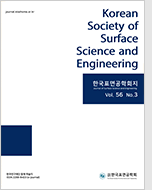
- Past Issues
- e-Submission
-

2021 Impact Factor 1.766
5-Year Impact Factor 1.674
Editorial Office
- +82-2-563-0935
- +82-2-558-2230
- submission@kssse.or.kr
- https://www.kssse.or.kr/

2021 Impact Factor 1.766
5-Year Impact Factor 1.674
The Korean Society of Surface Science and Engineering 2024;57(4):338-347. Published online: Sep, 9, 2024
DOI : 10.5695/JSSE.2024.57.4.338
α-MnO2 as a cathode material for Zn-ion batteries allows insertion and extraction of Zn ions within its tunnel structure during charge and discharge. The morphology and crystal structure of α-MnO2 particles critically determine their electrochemical behavior and energy storage performance. In this study, α-MnO2 was synthesized from precursor solutions under varying pH conditions using a hydrothermal method. The effects of pH values on the morphology, crystal structure, and electrochemical performance were systematically analyzed. The analysis revealed that materials synthesized at higher pH levels exhibited elongated and narrow nanorods with a lower specific surface area. In contrast, those formed at lower pH levels showed shorter, thicker nanorods with a higher specific surface area. This increased surface area at a lower pH enhanced the specific capacitance by providing a greater electrode/electrolyte interfacial area. By contrast, the material synthesized at higher pH conditions demonstrated superior rate capability, attributed to its crystal structure with wider lattice spacings. Wide lattice parameters in the material synthesized at higher pH conditions facilitated easier ion transport than at lower pH levels. Consequently, the study confirms that adjusting the pH of the precursor solution can optimize the electrochemical properties of α-MnO2 for Zn-ion batteries.
Keywords Hydrothermal, α-MnO2, pH control, Specific capacitance, Rate capability